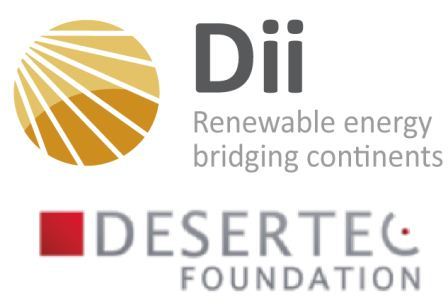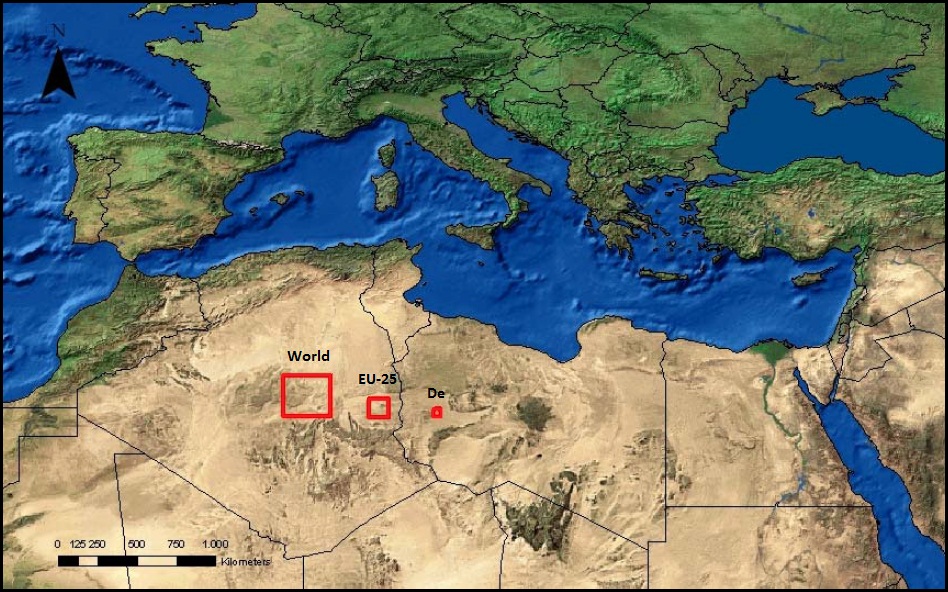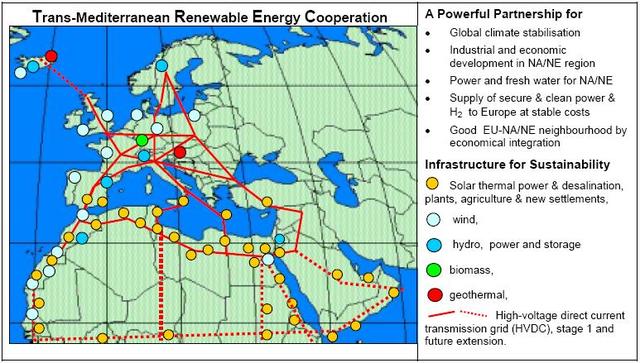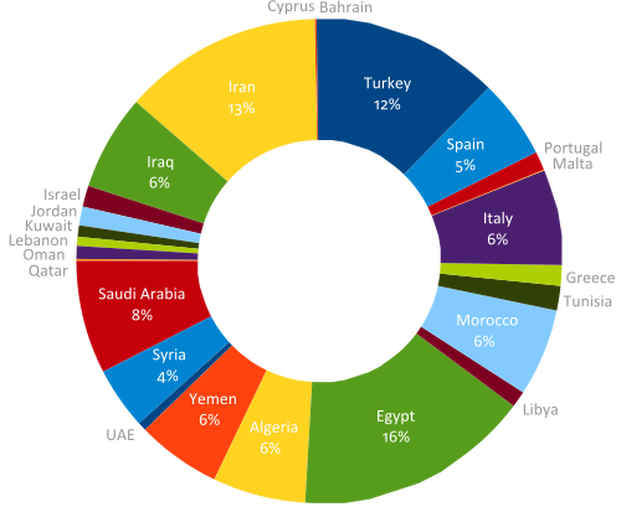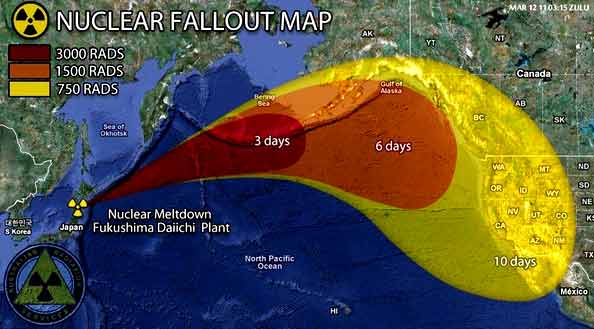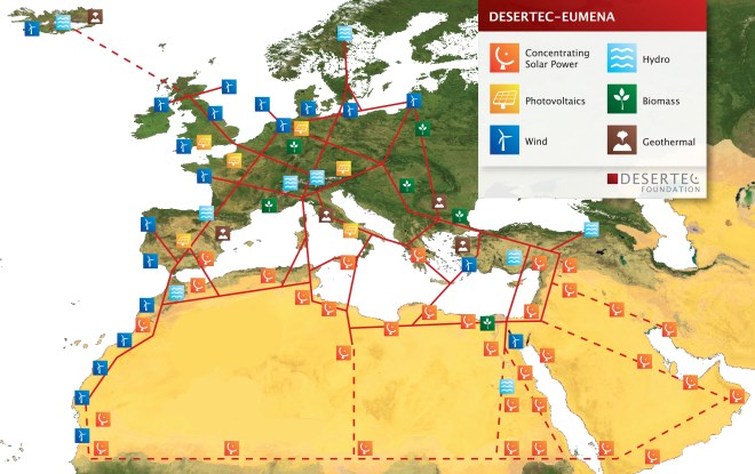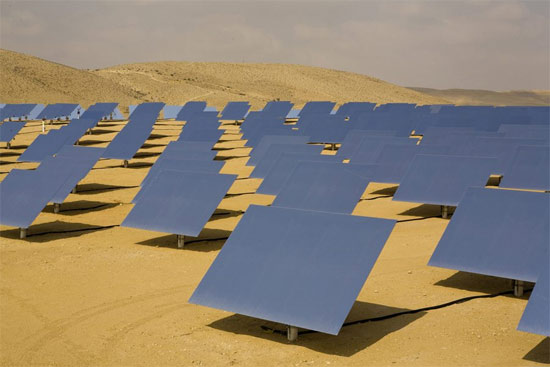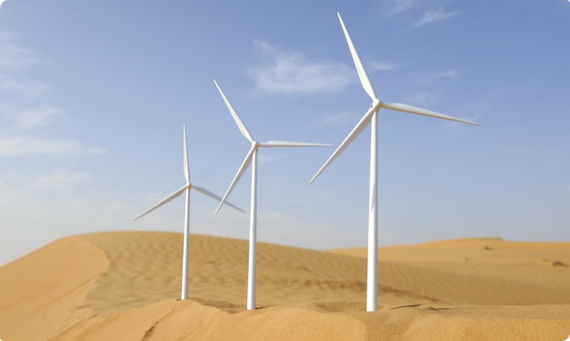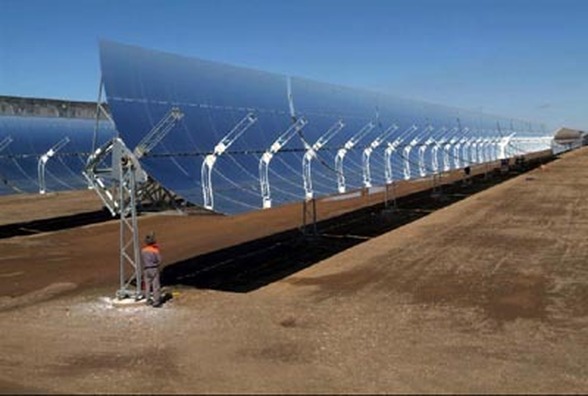Home
The Desrtec Plan – A Dot of Desert can Power the Earth
DESERTEC is a project supported by a consortium Dii created in Germany. It is a non-profit organization tasked with promoting the DESERTEC solution around the world. The project aims at creating a global renewable energy plan based on the concept of harnessing sustainable power from sites where renewable sources of energy are more abundant and transferring it through high-voltage direct current transmission to consumption centers.
All kinds of renewable energy sources are envisioned, but the sun-rich deserts of the world play a special role.
By taking into account land and water use, DESERTEC is intended to offer an integrated solution to food and water shortages in the coming decades.
The scientific studies done by the German Aerospace Center (DLR) between 2004 and 2007 demonstrated that the desert sun could meet rising power demand in the Middle East North Africa (MENA) region while also helping to power Europe, reduce carbon emissions across the EU-MENA region and power desalination plants to provide freshwater to the MENA region.
All kinds of renewable energy sources are envisioned, but the sun-rich deserts of the world play a special role.
By taking into account land and water use, DESERTEC is intended to offer an integrated solution to food and water shortages in the coming decades.
The scientific studies done by the German Aerospace Center (DLR) between 2004 and 2007 demonstrated that the desert sun could meet rising power demand in the Middle East North Africa (MENA) region while also helping to power Europe, reduce carbon emissions across the EU-MENA region and power desalination plants to provide freshwater to the MENA region.
Dii GmbH published a further study called Desert Power 2050 in June 2012. It found that the MENA region would be able to meet its needs for power with renewable energy, while exporting its excess power to create an export industry with an annual volume of more than €60 billion. Meanwhile, by importing desert power, Europe could save around €30/MWh.
The red squares represent the area that would be enough for solar power plants to produce a quantity of electricity consumed by the world today, in Europe (EU-25) and Germany (De). (Data provided by the German Aerospace Centre (DLR), 2005).
The DESERTEC concept was originated with Dr Gerhard Knies, a German particle physicist and founder of the Trans-Mediterranean Renewable Energy Cooperation (TREC) network of researchers. In 1986, in the wake of the Chernobyl nuclear accident, he was searching for a potential alternative source of clean energy and arrived at the following remarkable conclusion: “in just six hours, the world's deserts receive more energy from the sun than mankind consumes in a year”.
On 24 November 2011, a memorandum of understanding (MoU) was signed between the Medgrid consortium and Dii to study, design and promote an interconnected electrical grid linking DESERTEC and the Medgrid projects. The Medgrid together with DESERTEC would serve as the backbone of the European super grid and the benefits of investing in HVDC technology are being assessed to reach the final goal – the super-smart grid
All kinds of renewables will be used in the DESERTEC Concept, but the sun-rich deserts of the world play a special role.
The red squares represent the area that would be enough for solar power plants to produce a quantity of electricity consumed by the world today, in Europe (EU-25) and Germany (De). (Data provided by the German Aerospace Centre (DLR), 2005).
The DESERTEC concept was originated with Dr Gerhard Knies, a German particle physicist and founder of the Trans-Mediterranean Renewable Energy Cooperation (TREC) network of researchers. In 1986, in the wake of the Chernobyl nuclear accident, he was searching for a potential alternative source of clean energy and arrived at the following remarkable conclusion: “in just six hours, the world's deserts receive more energy from the sun than mankind consumes in a year”.
On 24 November 2011, a memorandum of understanding (MoU) was signed between the Medgrid consortium and Dii to study, design and promote an interconnected electrical grid linking DESERTEC and the Medgrid projects. The Medgrid together with DESERTEC would serve as the backbone of the European super grid and the benefits of investing in HVDC technology are being assessed to reach the final goal – the super-smart grid
All kinds of renewables will be used in the DESERTEC Concept, but the sun-rich deserts of the world play a special role.
The DESERTEC organisations promote the generation of electricity in Northern Africa, the Middle East and Europe using renewable sources, such as solar power plants, wind parks, and develop a Euro-Mediterranean electricity network, primarily made up of high voltage direct current (HVDC) transmission cables.
Under the DESERTEC proposal, concentrating solar power systems, photovoltaic systems and wind parks would be spread over the desert regions in Northern Africa like the Sahara desert. The generated electricity would be transmitted to European and African countries by a super grid of high-voltage direct currentcables.
Under the DESERTEC proposal, concentrating solar power systems, photovoltaic systems and wind parks would be spread over the desert regions in Northern Africa like the Sahara desert. The generated electricity would be transmitted to European and African countries by a super grid of high-voltage direct currentcables.
It would provide a considerable part of the electricity demand of the MENA countries and furthermore provide continental Europe with 15% of its electricity needs. Exported desert power would complement Europe's transition to renewables which would be based primarily on harnessing domestic sources of energy that would increase its energy independence.
According to a scenario by the German Aerospace Center (DLR), by 2050, investments into solar plants and transmission lines would be total €400 billion. An exact proposal how to realize this scenario, including technical and financial requirements, will be designed by 2012/2013 (see Desert Power 2050).
According to a scenario by the German Aerospace Center (DLR), by 2050, investments into solar plants and transmission lines would be total €400 billion. An exact proposal how to realize this scenario, including technical and financial requirements, will be designed by 2012/2013 (see Desert Power 2050).
A year after the nuclear disaster in Fukushima, the DESERTEC Foundation and the Japan Renewable Energy Foundation (JREF) have signed a MoU. They will exchange knowledge and know-how, and coordinate their work together to develop suitable framework conditions for the deployment of renewables and to establish transnational cooperation in Greater East Asia. The aim is to accelerate the deployment of renewable energy in Asia to provide secure and sustainable alternatives to fossil and nuclear power. As a part of its mission, JREF promotes the Asia Super Grid Initiative to facilitate an electricity system based fully on renewable energy. The DESERTEC Foundation sees such a grid as an important step towards the implementation of DESERTEC in Greater East Asia and has already conducted a feasibility study on potential grid corridors to make best use of the region’s desert sun.
The DESERTEC Concept was developed by an international network of politicians, academics and economists, called TREC. The research institutes for renewable sources of the governments of :
These above countries made significant contributions towards the development of the DESERTEC Concept. The basic studies relating to DESERTEC were led by DLR scientist Dr. Franz Trieb working for the Institute for Technical Thermodynamics at the DLR.
- Morocco (CDER),
- Algeria (NEAL),
- Libya (CSES),
- Egypt (NREA),
- Jordan (NERC) and
- Yemen (Universities of Sana'a and Aden) as well as the
- German Aerospace Center (DLR)
These above countries made significant contributions towards the development of the DESERTEC Concept. The basic studies relating to DESERTEC were led by DLR scientist Dr. Franz Trieb working for the Institute for Technical Thermodynamics at the DLR.
The studies concluded that the high solar radiation in the deserts of the Middle East and North Africa outweighs the 10–15% transmission losses between the desert regions and Europe. This means that solar thermal power plants in the desert regions are more economical than the same kinds of plants in southern Europe. The German Aerospace Center has calculated that if solar thermal power plants were to be constructed in large numbers in the coming years, the estimated cost of electricity would come down from 0.09–0.22 euro/kWh to about 0.04–0.05 euro/kWh.
The Sahara desert was chosen as an ideal location for solar farms as it is exposed to strong direct sunlight for much of the year (3,000 to 4,000 hours of sunlight per year). In addition, the desert is sparsely populated, making it possible to set up large solar farms without a negative impact on inhabitants of the region. Lastly, sand deserts can provide silicon, a raw material that is essential in the production of solar panels.
The Sahara desert was chosen as an ideal location for solar farms as it is exposed to strong direct sunlight for much of the year (3,000 to 4,000 hours of sunlight per year). In addition, the desert is sparsely populated, making it possible to set up large solar farms without a negative impact on inhabitants of the region. Lastly, sand deserts can provide silicon, a raw material that is essential in the production of solar panels.
Methodology Desert Power 2050 presents the full perspective of the EUMENA region, which includes, for instance, the growing consumption of power in the MENA states. The power requirements of the MENA states are likely to more than quadruple by 2050, totalling more than 3000 terawatt hours. Unlike in Europe, the population will also grow considerably by the middle of the century, thus heightening the demand for new jobs. Analysing the design of a power system built to include more than 90% renewables 40 years into the future is necessarily subject to major uncertainties on a range of assumptions. To address these uncertainties Dii analysed so-called sensitivities, or perspectives, to show how the results react to changed parameters. Dii has analysed a total of 18 perspectives on the EUMENA power supply in 2050. They cover a wide range of major impact factors on the attractiveness of power system integration. The main message of the study: grid integration across the Mediterranean is valuable under all foreseeable circumstances.
Dish Stirling
Concentrated solar power (also called concentrating solar power and CSP) systems use mirrors or lenses to concentrate a large area of sunlight, or solar thermal energy, onto a small area. Electrical power is produced when the concentrated light is converted to heat, which drives a heat engine (usually a steam turbine) connected to an electrical power generator. Molten salt can be employed as a thermal energy storage method to retain thermal energy collected by a solar tower or solar trough so that it can be used to generate electricity in bad weather or at night. Since solar fields feed their heat energy into a conventional generation unit with a steam turbine, they can be combined without any problem with fossil fuel hybrid power plants. This hybridization secures energy supply also in unfavourable weather and at night without the need of accelerating costly compensatory plants. A technical challenge is the cooling which is necessary for every heating power system. Dii is therefore reliant either on an adequate water supply, coastal facilities or improved cooling technology.
Concentrated solar power (also called concentrating solar power and CSP) systems use mirrors or lenses to concentrate a large area of sunlight, or solar thermal energy, onto a small area. Electrical power is produced when the concentrated light is converted to heat, which drives a heat engine (usually a steam turbine) connected to an electrical power generator. Molten salt can be employed as a thermal energy storage method to retain thermal energy collected by a solar tower or solar trough so that it can be used to generate electricity in bad weather or at night. Since solar fields feed their heat energy into a conventional generation unit with a steam turbine, they can be combined without any problem with fossil fuel hybrid power plants. This hybridization secures energy supply also in unfavourable weather and at night without the need of accelerating costly compensatory plants. A technical challenge is the cooling which is necessary for every heating power system. Dii is therefore reliant either on an adequate water supply, coastal facilities or improved cooling technology.
Photovoltaics
Dii also considers photovoltaics as a technology suitable for desert power plants. Photovoltaics is a method of generating electrical power by converting solar radiation into direct current electricity using semiconductors. Photovoltaic power generation employs solar panels composed of a number of solar cells containing a photovoltaic material. Materials presently used for photovoltaics include monocrystalline silicon, polycrystalline silicon, amorphous silicon, cadmium telluride, and copper indium gallium selenide/sulfide. Driven by advances in technology and increases in manufacturing scale and sophistication, the cost of photovoltaics has declined steadily since the first solar cells were manufactured.
In 2010, First Solar – a producer of thin film solar panels; joined Dii as associated partner.[60] The US based company already has experience with huge pv installations, and is currently constructing the 550 megawatt Desert Sunlight Solar Farm in California, which is supposed to be the biggest pv installation of the world.
Dii also considers photovoltaics as a technology suitable for desert power plants. Photovoltaics is a method of generating electrical power by converting solar radiation into direct current electricity using semiconductors. Photovoltaic power generation employs solar panels composed of a number of solar cells containing a photovoltaic material. Materials presently used for photovoltaics include monocrystalline silicon, polycrystalline silicon, amorphous silicon, cadmium telluride, and copper indium gallium selenide/sulfide. Driven by advances in technology and increases in manufacturing scale and sophistication, the cost of photovoltaics has declined steadily since the first solar cells were manufactured.
In 2010, First Solar – a producer of thin film solar panels; joined Dii as associated partner.[60] The US based company already has experience with huge pv installations, and is currently constructing the 550 megawatt Desert Sunlight Solar Farm in California, which is supposed to be the biggest pv installation of the world.
Wind energy
As also parts of the MENA region come with high wind potential, Dii is examining in which geographic regions the installation of wind farms is suitable. Wind turbines produce electricity by wind turning the blades, which spin a shaft, which connects to a generator which produces electricity.
High-voltage direct current (HVDC).
As also parts of the MENA region come with high wind potential, Dii is examining in which geographic regions the installation of wind farms is suitable. Wind turbines produce electricity by wind turning the blades, which spin a shaft, which connects to a generator which produces electricity.
High-voltage direct current (HVDC).
Arrays of parabolic troughs
The Sahara covers huge parts of Algeria, Chad, Egypt, Libya, Mali, Mauritania, Morocco, Niger, Western Sahara, Sudan and Tunisia. It is one of three distinct physiographic provinces of the African massive physiographic division.
First solar and wind power projects in North Africa already have started and countries like Morocco set up ambitious plans on the implementation of renewable energy. The Ouarzazate solar power plant in Morocco for example, with the capacity of 500 MW, will be one of the largest concentrated solar plants in the world.
The Sahara covers huge parts of Algeria, Chad, Egypt, Libya, Mali, Mauritania, Morocco, Niger, Western Sahara, Sudan and Tunisia. It is one of three distinct physiographic provinces of the African massive physiographic division.
First solar and wind power projects in North Africa already have started and countries like Morocco set up ambitious plans on the implementation of renewable energy. The Ouarzazate solar power plant in Morocco for example, with the capacity of 500 MW, will be one of the largest concentrated solar plants in the world.

